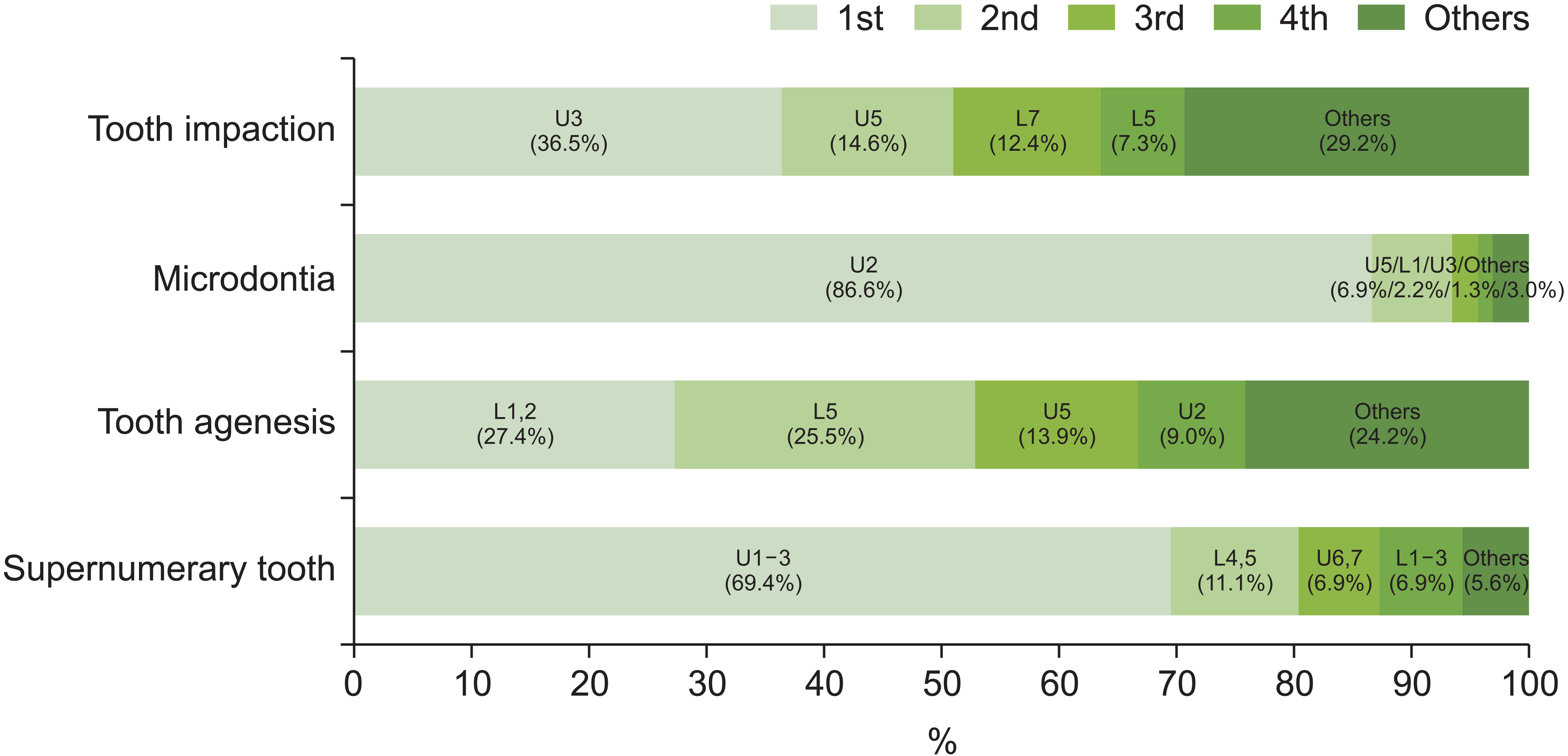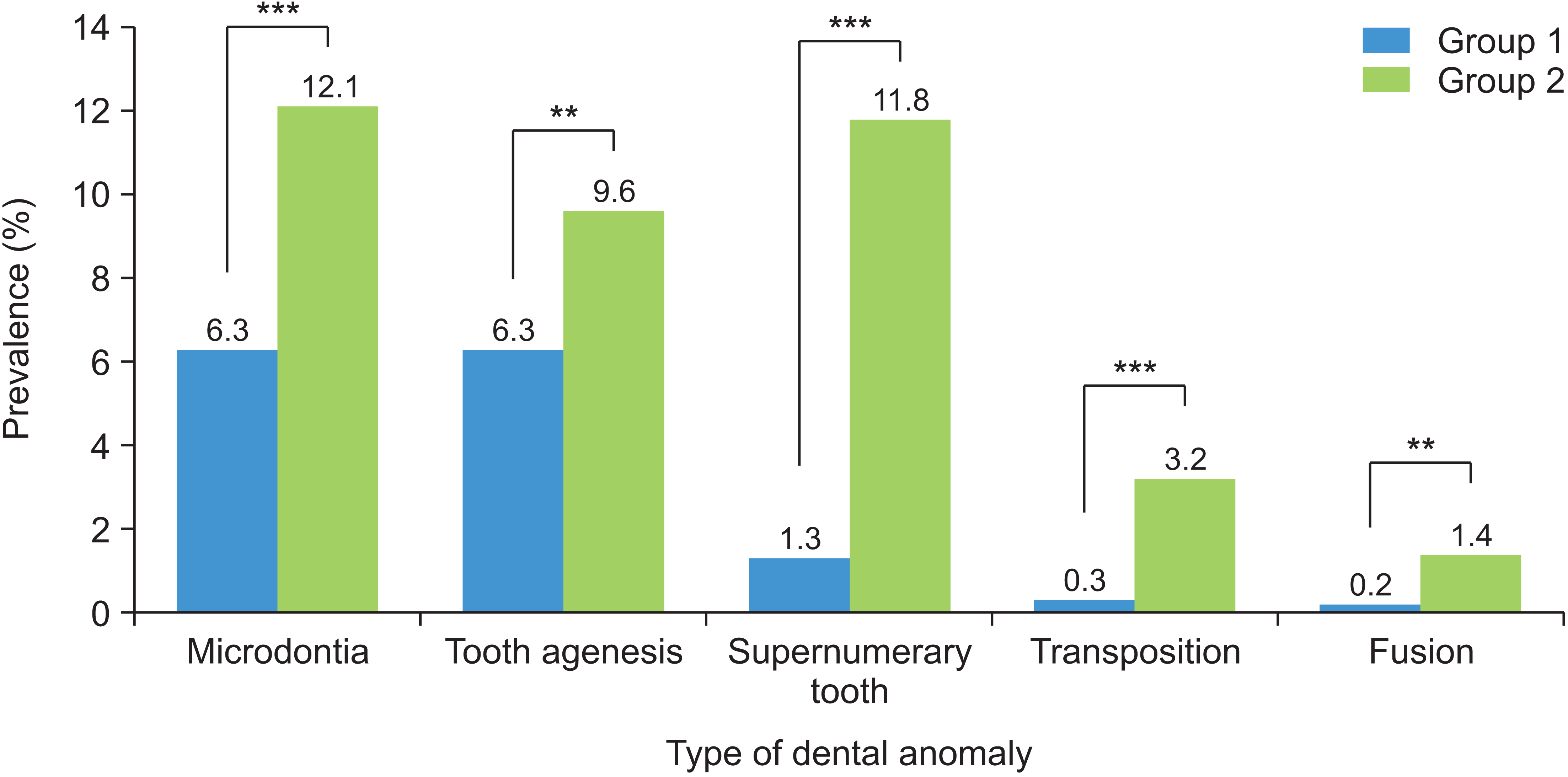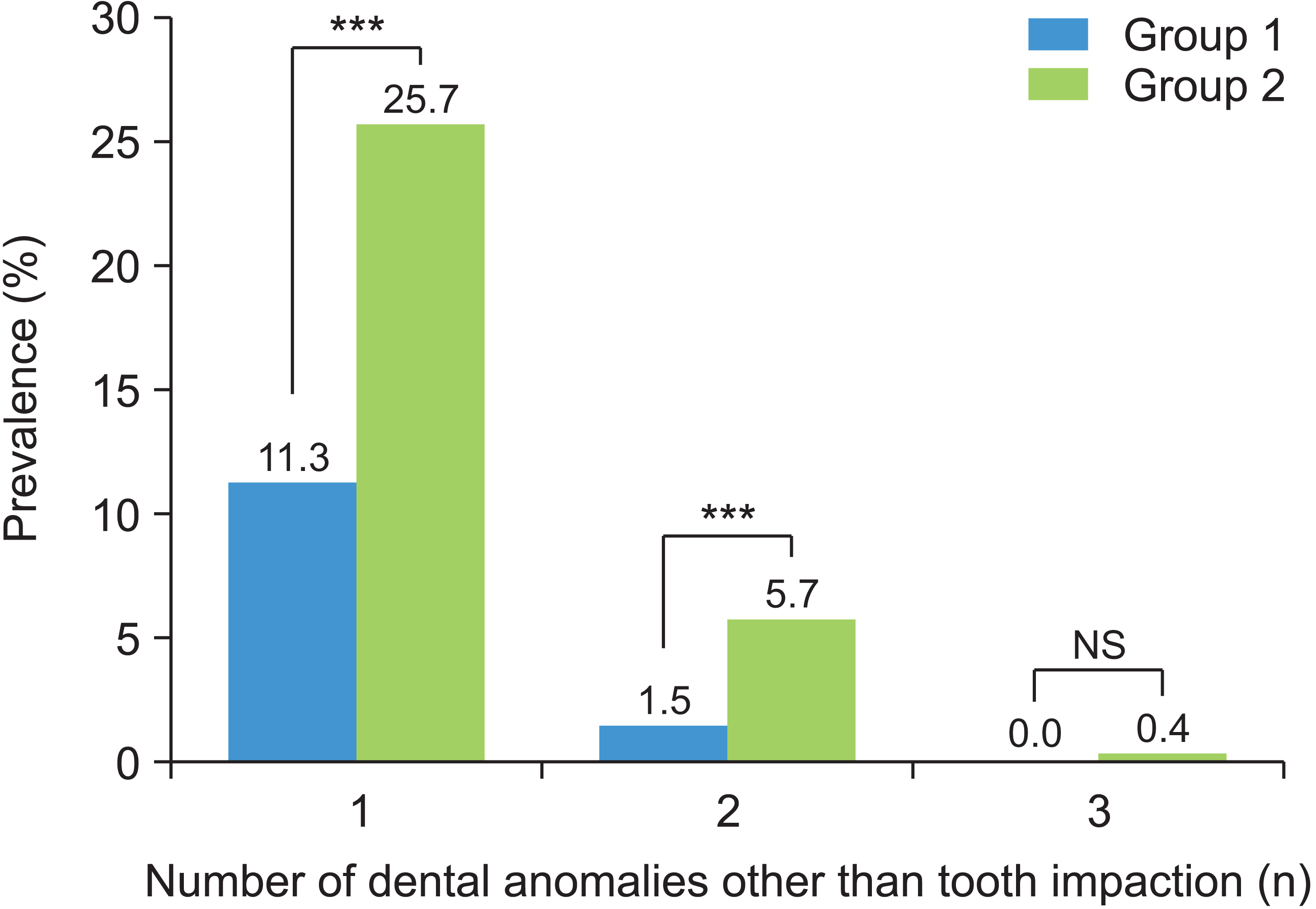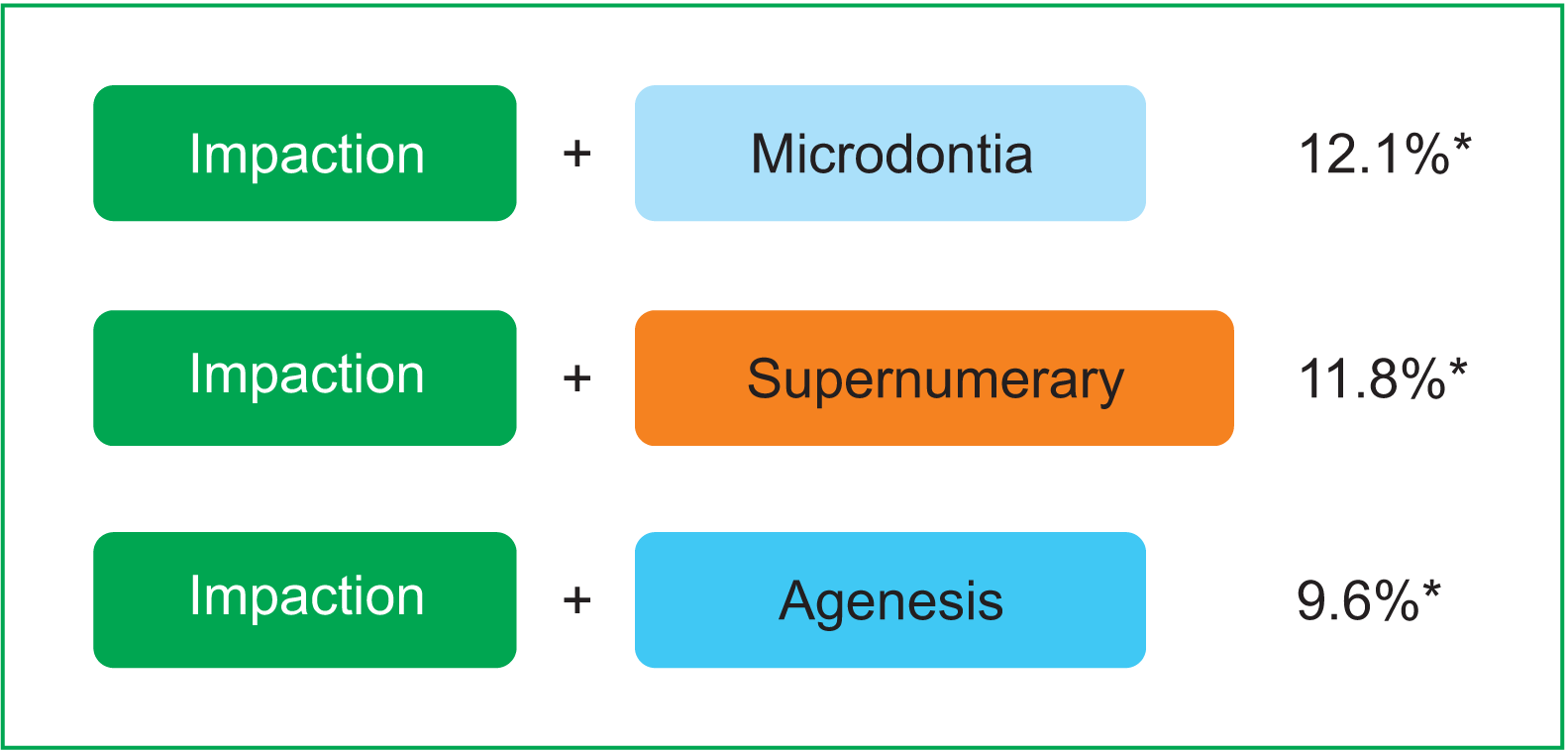INTRODUCTION
Dental anomalies (DAs) are defined as changes in the numbers, shapes, structures, exfoliations, and eruptions of teeth during dental development.
1,2 Tooth impaction, microdontia, tooth agenesis, and supernumerary tooth are the most common DAs encountered in clinical practice.
3,4 By affecting the number and size of teeth and the discrepancy of the arch length, these congenital anomalies can deteriorate both esthetics and function.
5 Furthermore, DAs of orthodontic patients tend to be more frequently compared to non-orthodontic patients.
6,7 Early diagnosis of DAs enables optimal planning of orthodontic treatment, reducing side effects, and the complexity of treatment.
8
Extensive literature has been reported on the prevalence and distribution of DAs in different populations.
3-9 In contrast, relatively few studies have demonstrated the association between the presence of DAs and the malocclusion type.
10-12 Fernandez et al.
10 found that DAs were most prevalent in Class III malocclusion and microdontia was significantly more frequent in Class III malocclusion. Basdra et al.
11 reported that Class III malocclusion showed significantly higher rates of DAs compared to Class II division 1 malocclusion. Uslu et al.
12 demonstrated that tooth impaction had a significantly lower prevalence in Class II and Class II division 2 malocclusion. The types of DAs investigated and diagnostic criteria for each DA vary in the literature, showing inconsistent results. Furthermore, due to differences in ethnicity and environmental factors, there are discrepancies in the prevalence of DAs in previous studies.
9,13 For the Korean population, there is little literature on the frequency and pattern of DAs in relation to the malocclusion type or skeletal feature. To date, only a few studies have reported the prevalence of hypodontia according to the type of malocclusion.
14,15
The prevalence of tooth impaction is known to be the highest among the different types of DAs even when excluding the impaction of third molars, and ranges from 3.1% to 13.7% depending on the characteristics of the population.
4,8,16 Laganà et al.
8 reported that the most frequently impacted teeth were the maxillary canine, followed by maxillary lateral incisors, and maxillary central incisors. The prevalence pattern may be different in Korean population.
In patients with impacted teeth, a concurrent supernumerary tooth, or a small-sized tooth, is often encountered. Baccetti
17 demonstrated the existence of associations among different DAs and emphasized the importance of early diagnosis of one anomaly as it is an indicator of a higher risk of other DAs. Peck et al.
18 discovered that patients with a palatally displaced canine (PDC) tooth have a higher incidence of permanent tooth agenesis and small lateral incisors. Sigler et al.
19 also showed that subjects with PDC exhibited a significantly higher prevalence of small lateral incisors and distoangulation of the second mandibular premolars. However, these studies investigated only individuals affected by DAs and a comparison with a control group was absent.
18-20 For the Korean population, there have been few studies on the association between tooth impaction and other common DAs.
Therefore, the purpose of this study was 1) to investigate the prevalence and pattern of DAs, 2) to compare DAs according to the type of malocclusion, and 3) to investigate the correlation between tooth impaction and other DAs in the Korean orthodontic population.
MATERIALS AND METHODS
Study population
The subjects of the present study included 3,753 patients who visited the Department of Orthodontics at Seoul St. Mary’s Hospital, the Catholic University of Korea and underwent a diagnostic examination for orthodontic treatment between September 2002 and October 2019. The minimum age of the sample was 6 years, and any patient with a history of orthodontic treatment, multiple dental prosthesis, tooth loss, craniofacial disorders, incomplete records, or a tooth (or teeth) whose identification was unclear in the records was excluded. Furthermore, if there was uncertainty in the diagnosis of DAs, it was confirmed through follow-up panoramic radiographs or excluded from the sample. A final sample consisting of 3,240 patients (mean age, 22.2 ± 11.6 years) was included in the study. The presence and location of common DAs; tooth impaction, microdontia, tooth agenesis, supernumerary tooth, transposition, and fusion were identified by examination of their initial diagnostic records. This study was approved by the institutional review board of the Catholic University of Korea (KC20RISI0442 and KC21RISI0109).
Characterization of malocclusion type
The type of malocclusion in this study was defined according to the anteroposterior relationship of the maxilla and the mandible. The type of malocclusion was classified according to the value of the A point–Nasion–B point (ANB) angle measured in the lateral cephalograms, as follows.
- Class I (ANB angle with values between 0° and 4°)
- Class II (ANB angle with values > 4°)
- Class III (ANB angle with values < 0°)
Diagnosis of dental anomalies
Pretreatment diagnostic records including clinical photographs, panoramic radiographs, lateral cephalograms and cone-beam computed tomography images, if any, were examined to identify the following DAs:
Tooth impaction: a tooth that was buried in the bone or gingiva obstructed on its normal eruption path and failed to erupt after the normal eruption period, except for the third molar.21
Microdontia: a tooth smaller than the normal tooth size on the opposite side when comparing the mesiodistal width of the crown.22
Tooth agenesis: the developmental absence of at least one permanent tooth, also known as hypodontia and congenitally missing tooth, except for the third molar.23 To exclude uncertainty, the central or lateral mandibular incisors were counted together.
Supernumerary tooth: an excess of the regular number of teeth, with an additional tooth, which may be erupted or unerupted8,21
Transposition: an unusual type of ectopic eruption or positional interchange of two teeth8
Fusion: the union between the dentin or enamel of two or more separated tooth germs24
Group classification according to the presence or absence of an impacted tooth
The subjects were further classified as Group 1 without an impacted tooth (control group) or Group 2 with an impacted tooth (impaction group). The inclusion criteria for Group 2 were the presence of one or more permanent impacted teeth, excluding the impacted third molars. An impacted supernumerary tooth or an impacted third molar was not included in Group 2. The following DAs were detected; tooth impaction, agenesis, supernumerary tooth, microdontia, transposition, and fusion.
Statistical analysis
All measurements were examined by the same investigator and were repeated after two weeks. The systemic intraexaminer error between the two measurements was evaluated with a paired t-test. The extent of the measurement error between the first and second evaluations was also assessed by calculating the intraclass correlation coefficient. Patients and the DAs rates were stratified by sex and type of malocclusion. To determine the statistical significance of DAs by sex and malocclusion type, the chi-square test (sex) and chi-square test with Bonferroni correction (malocclusion type) were conducted. In addition, the chi-square test was used to compare the prevalence of impacted teeth and their relationship with other DAs in each group. The level of significance in all tests was set at 5% (p < 0.05). The Phi correlation coefficient was calculated to assess the correlation between the DAs. A Phi coefficient of 0.1 to 0.3 was interpreted as a weak correlation, 0.3 to 0.5 as moderate, and 0.5 to 1.0 as a strong correlation. All statistical analyses were performed using SPSS ver. 20.0 (IBM Corp., Armonk, NY, USA).
DISCUSSION
Dental anomalies can be classified into various types in relation to the number, shape, size and location of teeth.
25 Some are observed relatively often and should be considered in advance during orthodontic treatment planning because they affect function, aesthetics, or occlusion.
12 Tooth impaction, microdontia, tooth agenesis, and supernumerary tooth, which are known as the four most common DAs,
3,4 were mainly investigated here. As in many other studies, tooth impaction showed the highest prevalence. Additionally, the prevalence of the four DAs was similar or greater than that of previous reports.
4,10,11 Investigations of the general population or general dental patients showed a lower prevalence, while studies focusing on orthodontic patients at university-affiliated general hospitals indicated similar prevalence rates with this study. In other words, orthodontic patients in general hospitals are more likely to be referred due to different DAs as well as skeletal discrepancies.
6,26
With regard to sex-based differences, there was a significant difference only in the prevalence of supernumerary tooth. The supernumerary tooth is known to occur twice as often in males than in females and the prevalence is 1.5–3.5% in the permanent dentition.
27,28 The results of this study showed the same prevalence range and males were more frequently affected than females at a ratio of 2.2:1. Furthermore, the average number of affected teeth per individual was investigated, and only tooth agenesis affected more than two teeth, which is consistent with a previous study by Fernandez et al.
10
The prevalence of the four DAs was highest in Class I (23.4%), followed by Class II (21.4%) and Class III (17.3%) regardless of the type of DA (
Table 4). However, for each DA, significant differences among different malocclusion types were found for tooth impaction, tooth agenesis, and supernumerary tooth (
Table 1). Tooth agenesis was detected more frequently in Class II (8.1%) malocclusion than in Class III (5.3%) malocclusion in this study. However, Celikoglu et al.
29 found that hypodontia was significantly less frequent among patients with skeletal Class II malocclusion, and Chung et al.
14 showed that hypodontia was associated with skeletal Class III malocclusion.
Maxillary teeth were more often affected by DAs than mandibular teeth, except for tooth agenesis (
Table 2). In Class III malocclusion, both tooth impaction and tooth agenesis were found to be more common in the maxilla than in Class I or Class II malocclusion. Therefore, it may be postulated that the relative size of the maxilla and mandible appears to be related to the distribution of these two DAs, i.e., tooth impaction and tooth agenesis.
To our knowledge, no study has examined the most frequently affected tooth among DAs according to the type of malocclusion. For tooth agenesis, the most frequently affected teeth were, in order, the mandibular incisors, the second mandibular premolars, and the second maxillary premolars, reflecting the same results as Chung et al.
14 The proportion of missing mandibular incisors was particularly high (33.1%) in the Class II group. This result may indicate an increase in the difficulty of treatment in Class II patients with missing mandibular incisors. This high prevalence of mandibular incisor agenesis was suggested as a characteristic of the hypodontia pattern of ‘mongoloids' by Kim.
15
The most frequently affected teeth by microdontia were the maxillary lateral incisors, known as peg lateralis. In addition, the majority of supernumerary tooth occurred in the premaxilla, for example, in the mesiodens (
Figure 1). The same results have already been reported in various studies.
8-10 The most commonly impacted tooth was the maxillary canine among all malocclusion types (
Table 3). The second most impacted tooth was the mandibular second molar in Class I and Class II malocclusion, and the maxillary second premolar in Class III malocclusion and in the total sample. Since Class III patients (n = 1,430, 44.1%) accounted for a large proportion of the total sample, the overall trend would have been the same as that of the Class III group. The impaction of the maxillary second premolar may induce a decrease in the maxillary arch length, making it more difficult to treat Class III malocclusion already complicated with anteroposterior jaw disharmony.
Since tooth impaction was the most common DA and may lead to severe side effects such as root resorption, tooth loss, and gingival problems,
30 the total sample was grouped according to the presence or absence of an impacted tooth. The prevalence of an impacted tooth (Group 2) was 8.6% (n = 280), which was higher than the 3.09% reported by Lee et al.
4 In another study by Fardi et al.
16 evaluating the Northern Greek population, the incidence of impacted teeth was 13.7%. One of the reasons for this may be methodological differences, for example, the definition of impacted tooth and selection of the sample. They considered an unerupted supernumerary tooth as an impacted tooth,
16 while in this study, the supernumerary tooth as well as the impacted third molars were considered as additional teeth and were not included as an impacted tooth.
When the prevalence of all other DAs except the impacted tooth was compared between the groups (
Table 5 and
Figure 2), the prevalence was significantly higher in the impaction group (Group 2) than in the control group (Group 1). In particular, the prevalence of a supernumerary tooth and an impacted tooth in Group 2 (11.8%) was approximately ten times higher than the solitary presence of a supernumerary tooth in Group 1 (1.3%). Furthermore, the prevalence of multiple concurrent DAs such as simultaneous tooth agenesis, microdontia, supernumerary tooth or teeth was also significantly higher in Group 2 than in Group 1 (
Table 6 and
Figure 3). The most common patterns of concurrent DAs with tooth impaction in our study have been summarized in
Figure 4, since understanding these common patterns would be clinically useful.
Regarding the associations between impacted teeth and other DAs, tooth impaction had a significant relationship with supernumerary teeth, transposition, and fusion (0.1 ≤ Phi < 0.3) (
Table 7). Additionally, microdontia and tooth agenesis showed a correlation with supernumerary tooth, transposition, and fusion. The associations between tooth impaction and supernumerary/transposition and between tooth agenesis and transposition have also been reported by Laganà et al.
8 Baccetti
17 also demonstrated significant reciprocal associations between the agenesis of the second premolars, the peg lateralis, and the palatal displacement of maxillary canines, suggesting their common heredity. In this study, tooth agenesis was often discovered as multiple missing teeth state. Most supernumerary teeth were located in the maxillary anterior region, including mesiodens located between the two maxillary central incisors. Since maxillary canines, excluding third molars, were also the most commonly impacted teeth in many previous reports,
4,16,21 a number of investigations dealing only with impacted maxillary canines have been described. Several previous reports have demonstrated a statistically significant association between PDC and other tooth impactions, agenesis, transposition, and peg-shaped maxillary lateral incisors.
According to this study, there was a greater possibility that patients with tooth impaction would have other DAs at the same time. Additionally, significant relationships among DAs suggest that an anomaly may present a potential risk of other anomalies. Therefore, a more thorough examination and follow-up would be required for patients with tooth impaction. In addition, early detection and accurate diagnosis of other possible DAs can decrease the complexity of treatment and provide optimal treatment for orthodontic patients.




 PDF
PDF Citation
Citation Print
Print







 XML Download
XML Download